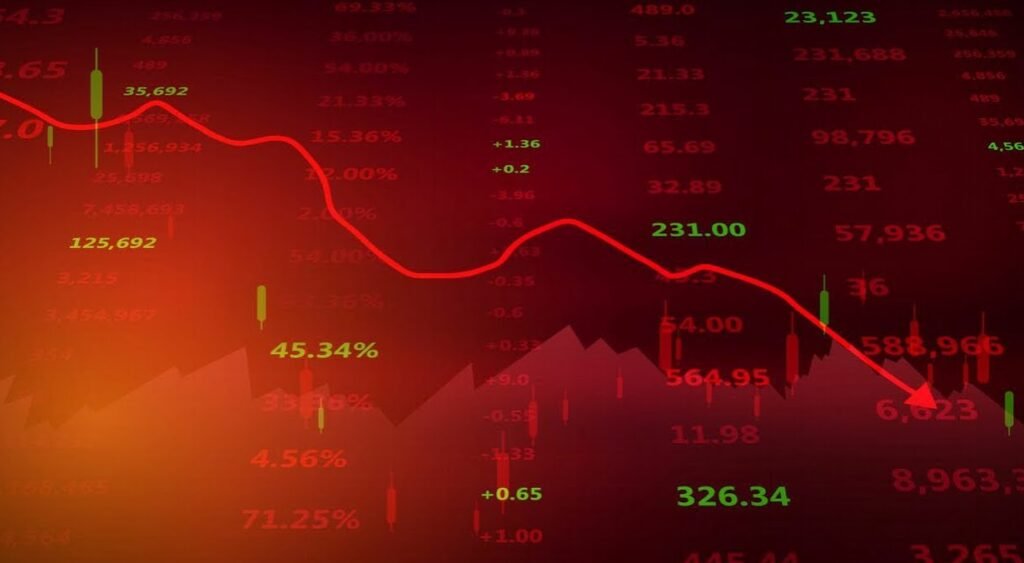The Crypto market crash in June 2025 had its most significant drop in a single day, when rising tensions between Israel and Iran shook global financial markets. The digital asset ecosystem, once seen as a possible haven during times of uncertainty, proved to be vulnerable to geopolitical events when investors shifted to traditional safe-haven assets amid rising tensions in the Middle East.
Immediate Market Impact and Liquidation Cascade
After news of Israeli airstrikes on Iran, the total value of all Crypto market crash June 2025 fell by billions of dollars in just a few hours. The market capitalisation of cryptocurrencies fell by seven per cent. Bitcoin, the largest cryptocurrency in the world by market capitalisation, experienced its lowest day since early June, falling 3.3% to $103,556 as panic selling dominated the market.
The selling pressure triggered a massive cascade of liquidations, wiping out more than $1.16 billion in leveraged holdings within 24 hours. This was one of the most significant forced liquidation events of 2025. Long holdings took the biggest hit in the market crash, with Bitcoin losing $448.1 million and Ethereum losing $288.4 million in forced closures. Solana lost $52.1 million, Dogecoin lost $27.6 million, and XRP lost $23 million, all of which were significant losses for other cryptocurrencies.
Cryptocurrency’s Geopolitical Sensitivity
The dramatic drop in cryptocurrency values following the Israel-Iran crisis demonstrates that the digital asset market remains closely tied to traditional risk assets during periods of geopolitical uncertainty. In the past, many have referred to Bitcoin as “digital gold” or a safe-haven asset. However, recent events suggest that cryptocurrencies behave more like growth stocks during times of crisis, with prices fluctuating and people withdrawing their money from them.

This pattern has occurred before, as cryptocurrency markets have been significantly impacted by geopolitical events such as the Russia-Ukraine conflict, US-China trade tensions, and past conflicts in the Middle East. When investors perceive the world as becoming riskier, they typically shift their investments away from high-risk assets and toward safer options, such as government bonds, gold, and established fiat currencies.
The Broader Economic Context
The tensions between Israel and Iran come at a time when the global economy is already quite complicated, which has kept bitcoin investors on edge all year. Digital currencies and other risk assets have struggled due to concerns about rising inflation, uncertain central bank policies, and fluctuating energy prices.
Conflicts in the Middle East that impact the energy industry pose significant threats to cryptocurrency markets through several avenues. When oil prices rise, it may cause inflation, which could prompt central banks to maintain or increase interest rates. This makes financial markets less liquid, making yield-bearing assets more appealing than cryptocurrencies that don’t pay interest. If regional tensions worsen, JPMorgan analysts predict that oil prices could reach $120 per barrel. This would make things even more complicated for risk assets.
Market Structure and Leverage Concerns
The number of sell-offs during the current market downturn indicates that people remain concerned about excessive leverage in the cryptocurrency markets. The $1.16 billion in forced position closures highlights the extent to which traders had been borrowing money to increase their exposure to digital assets. This created systemic concerns that became apparent when prices began to drop rapidly.
In the last few years, cryptocurrency derivatives markets, including futures and perpetual contracts, have undergone significant development. This gives traders more leverage, but it also makes the market more volatile when things get tough. When margin calls force leveraged positions to close, the resulting selling pressure may cause prices to drop further and lead to additional liquidations.
Regional Implications and Safe Haven Dynamics
The current situation has reignited discussions about whether Bitcoin may be a safe place to store money during times of political unrest. Some people who support cryptocurrencies argue that digital assets offer protection against hazards in the traditional financial system and currency debasement. However, recent market activity suggests that institutional investors continue to view cryptocurrencies as risky investments rather than safe havens.
As tensions between Israel and Iran rose, investors sought safety in traditional safe-haven assets, including US Treasury bonds, gold, and the Swiss franc. This flight to quality indicates that, despite institutions’ use of cryptocurrencies and regulatory improvements over the years, they are still not widely accepted as a store of wealth that can withstand crises.
Technical Analysis and Support Levels
Bitcoin’s drop below critical psychological levels has made it harder to sell since automated trading systems and technical traders react to chart patterns and momentum indicators. The drop below $105,000 triggered stop-loss orders and automated selling systems, which accelerated the decline.

Crypto market crash June 2025 specialists are closely monitoring key support levels. Many believe that the $100,000 psychological barrier for Bitcoin may be a point where bulls and bears clash. If the price remains below this level for an extended period, it could indicate further downside potential and increased selling pressure.
Institutional Response and Market Sentiment
The institutional Bitcoin community has reacted to the geopolitical tensions with cautious care. Several major investment organisations have reduced their digital asset holdings and increased their cash reserves. This type of activity by institutions indicates a broader risk-off mood that has been prevalent in financial markets during periods of heightened geopolitical concern.
Corporate treasury departments that had previously allocated some of their cash reserves to Bitcoin are now reevaluating their cryptocurrency holdings. Some companies are reducing their digital assets to stabilise cash flow and balance sheets.
Recovery Prospects and Market Outlook
Some people in the cryptocurrency market believe that the current sell-off could be a good opportunity to buy, even though prices have dropped sharply. They say that the primary reasons for long-term cryptocurrency acceptance are still in place. These hopeful individuals argue that the ongoing construction of institutional infrastructure, improvements in regulatory clarity, and technological advancements are all reasons to maintain a positive long-term outlook, even while things remain volatile in the short term.
The recovery of the bitcoin market will likely depend on how quickly geopolitical issues are resolved and how stable the market remains. Historical data show that cryptocurrency markets can be highly volatile for extended periods amid prolonged geopolitical crises. This is because investors are less willing to take risks, and money flows to traditional safe-haven assets.
Risk Management Considerations
The recent market chaos highlights the importance of managing risk effectively when investing in cryptocurrencies. Big liquidations underscore the hazards of leverage, and the market decline indicates that cryptocurrency prices remain tied to global risk sentiment.
In light of recent volatility, both professional investors and retail traders are reevaluating how they construct their portfolios and manage their risks. To deal with any future market upheavals, many are using position size tactics, using less leverage, and keeping larger cash reserves.
Looking Forward: Market Resilience and Lessons Learned
As the immediate shock of the geopolitical tensions begins to wear off, the cryptocurrency markets will likely undergo a period of price discovery and consolidation. The fact that digital asset infrastructure held up during the latest stress test, including exchange uptime and transaction processing capacity, gives us some confidence in the market’s operational stability, even as prices fluctuate.
People will likely remember what happened on June 13, 2025, as another critical test of the cryptocurrency market’s maturity. Despite their growth and widespread use by institutions for years, digital assets remain subject to global economic and political shifts.


